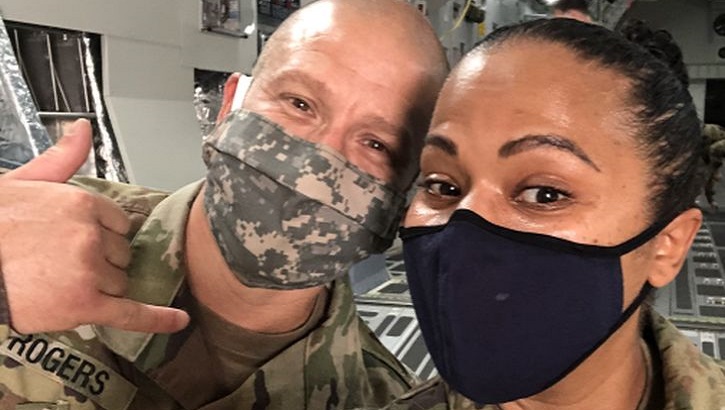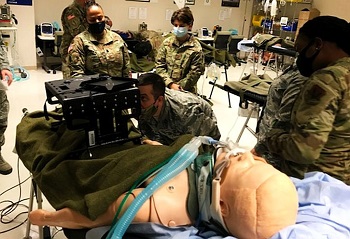Burn Flight Team chief discusses mission, care at USAISR Burn Center
 Army Lt. Col. (Dr.) Alicia Williams (right) poses with Air Force Capt. Ethan Rogers, a USAISR intensive care unit nurse, during a Critical Care Air Transport course. To increase interoperability, the Army Burn Flight Team has recently started cycling personnel through the Air Force’s CCAT course (Photo by: Army Lt. Col. (Dr.) Alicia Williams).
Army Lt. Col. (Dr.) Alicia Williams (right) poses with Air Force Capt. Ethan Rogers, a USAISR intensive care unit nurse, during a Critical Care Air Transport course. To increase interoperability, the Army Burn Flight Team has recently started cycling personnel through the Air Force’s CCAT course (Photo by: Army Lt. Col. (Dr.) Alicia Williams).
For Army Lt. Col. (Dr.) Alicia Williams, U.S. Army Institute of Surgical Research’s multi-faceted mission provides opportunities as a surgeon and a medical professional and truly lives up to the institute’s tenants of research, clinical care, and education.
Williams serves as the chief medical officer for the Army Burn Flight Team, which is part of USAISR's Burn Center located at Joint Base San Antonio-Fort Sam Houston, and consists of an acutely trained doctor, nurse, and a respiratory therapist. The team has conducted nearly 100 overseas missions since 2003 and can deploy globally within 12 hours. They can provide in-flight care for both military and civilian patients.
"We transport burned, injured warfighters from overseas. We're essentially the Army's version of the Air Force Critical Care Air Transport team," explained Williams, who is also a general and burn surgeon at USAISR. "We are available to pick up burn patients anywhere in the world. We will come pick up any active-duty service member who suffers a serious burn."
Looking toward better interoperability, the Army Burn Flight Team recently started cycling personnel through the Air Force's CCAT course.
"The goal is to eventually be able to do joint missions, with everyone on the Burn Flight Team being CCAT qualified," said Williams. "Right now, we're in the process of figuring out how the flight team and CCAT can work best together on training and going out and getting patients."
Williams explained how events like a future Joint Emergency Medical Exercise will give the flight team a chance to work closer with their Air Force counterparts.
Aside from the flight team, the team at USAISR consists of multiple general and specialized burn surgeons, the latter being Williams' area of expertise.
"I see what a general surgeon sees, but I also see patients in the [burn] ward, the intensive care unit and the clinic who have burned themselves, have necrotizing soft tissue infections or frostbite," said Williams.
She also explained how the recent unexpected winter storm that struck Texas resulted in an uptick in both frostbite and fire-related injuries at both the USAISR and in Brooke Army Medical Center's emergency room – also located at JBSA-Fort Sam Houston.
 Soldiers and Airmen train together during Critical Care Air Transport course. To increase interoperability, the Army Burn Flight Team has recently started cycling personnel through the Air Force’s CCAT course (Photo by: Army Lt. Col. (Dr. Alicia Williams).
Soldiers and Airmen train together during Critical Care Air Transport course. To increase interoperability, the Army Burn Flight Team has recently started cycling personnel through the Air Force’s CCAT course (Photo by: Army Lt. Col. (Dr. Alicia Williams).
Given that, Williams said that this is a good time to remind service members to keep safety in mind when using items like space heaters, grills, and propane tanks, as well as around fires.
"Pay attention to those holiday safety briefs because there actually is truth to them," said Williams.
Another element of what USAISR does is research, which is guided by what an individual is interested in. Williams said she appreciates the freedom and opportunities to collaborate with her colleagues.
"What's nice about the research we do here is that you can find something you like and design a research project around it or find someone who is already doing it and join in with them," said Williams. "Everybody is very collaborative. If you can't find a project, you can just send an email out or talk to someone about what you're interested in, and they'll likely know someone who is working on it."
Williams is working on developing an application to help train medical personnel who are going downrange in estimating the severity of burns.
"If you don't see burns all of the time, there's a tendency to over- or underestimate how severe they are," said Williams.
The app will use photos and charts to help medical personnel better estimate a burn's severity.
Although part of the Military Health System, USAISR sees a preponderance of civilian patients.
"Being able to take care of civilians is what keeps our clinical readiness up," said Williams. "The burn center has a special designation for working with civilians so that they can keep coming back here for their follow-up care."
This program includes things like base access and includes patients from all over Texas and beyond.
Williams said the most rewarding part of her job is seeing a patient recover from their injuries.
"There's a lot that goes into their recovery," said Williams. "Large burns are very labor-intensive. When you see a patient day after day, week after week, and watch their wounds heal, especially on a large burn, there's nothing better than seeing them completely healed. At the very end, you're looking at them and it's amazing.
Williams recounted a story of watching a patient standing up during rehabilitation, after not being able to walk for nearly a year. It caught her in the moment.
"I didn't realize how emotional that would make me," said Williams.
"I think that's the best part of being a surgeon in general, really," said Williams. "Something that you've intervened on, that you've worked on has really helped someone exponentially."